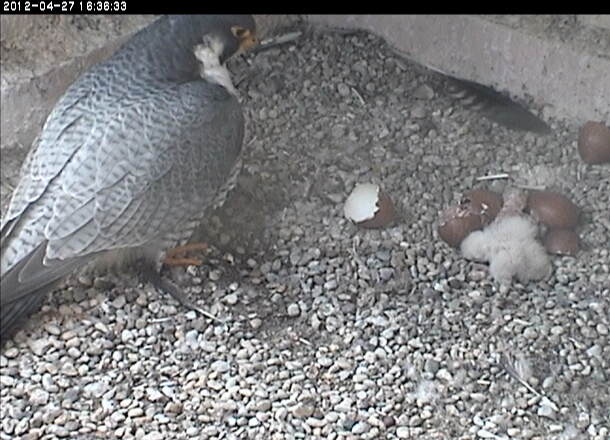
Question: How soon will the eggs hatch?
Answer: Peregrine eggs hatch “about a month” after incubation begins. Birds of the World says the time span is …
According to A. Hagar (in Bent 1938b), incubation period is 33–35 days, not 28–29 days, as commonly stated. Based on captive falcons, about 33.5 days. Direct observation of identified eggs in wild near San Francisco, CA, was 37 days (B. Walton pers. comm.), possibly related to long or frequent periods of interrupted incubation.
— Birds of the World: Peregrine Falcon account
Incubation begins when the parent bird touches the eggs with the bare skin of his/her brood patch. Before incubation, the bird allows body feathers to intervene while covering the eggs. Birds of the World says that in temperate latitudes (Pittsburgh) incubation begins when the penultimate (next-to-last) egg is laid.
By delaying incubation until the penultimate egg all the eggs, except the last, hatch on the same day. The last egg is younger so it hatches that much later.
From 2009-2013 I tracked both next-to-last-egg and hatch dates for Dorothy, the matriarch at the Cathedral of Learning. Dorothy’s incubation period averaged 33.7 days.
Hatch date can also be calculated from first-egg-date but is complicated if the number of eggs varies year to year. Virginia DWR calculates incubation from first-egg for the Richmond falcons at 38 days. Dorothy’s first-egg-to-hatch averaged 38.7 days (normalized to 4-egg clutches).
Here are example hatch dates for next-to-last-egg = 22 March and first-egg = 17 March.
- Birds of the World‘s 33-35 days after penultimate egg puts Hatch Day on 24 -26 March.
- Dorothy’s 33.7 days after penultimate egg (and 33.5 days in captive falcons) says Hatch Day will be late on 24 March.
- First-egg + 38 days (per Dorothy and the Richmond falcons) sets Hatch Day on 25 March.
For more information on incubation, read The Big Sit
For information on how the chick gets out of the egg, see How Do They Hatch?
(photo from the National Aviary webcam at University of Pittsburgh, 30 April 2008)
…
p.s. It is way too easy to find conflicting incubation time spans for peregrine eggs. These links point to sources that say 30 days, 33 days, 29-32 days, 29-33 days. Also, there is a website that says incubation begins on the day before last egg is laid.
The picture at both scrapes are much better this year than last – the new cameras make a big dfference. Do they have remote control to move them or do they have to be physically changed and adjusted ?
The camera at University of Pittsburgh has zooming and autofocus capabilities. Right now it is zoomed in during incubation. It will be zoomed back out when the young birds begin to move. The zoom feature is only accessible to those who manage the camera.
The camera at Gulf Tower is older and must be adjusted manually. It cannot be zoomed, but must be physically moved closer if you want a closer picture. This cannot be done during the nesting season because people are not allowed near the nest, so what you see now is what it will look like this year.